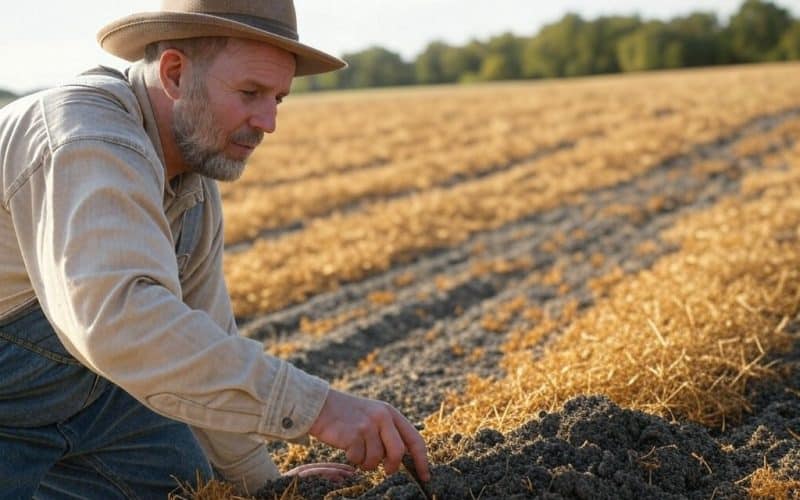
Carbon removal on farms is gaining traction as a climate mitigation strategy. By implementing methods such as enhanced rock weathering and biochar application, farms can act as carbon sinks, reducing atmospheric CO₂ levels.
However, these techniques also influence Earth’s reflectivity (albedo), which can have complex climatic consequences which for instance is mentioned in this recent New Scientist article. Understanding the mechanisms, benefits, and potential drawbacks is essential for developing balanced and effective strategies. And that is what we will do in this article.
How Carbon Removal Methods Work
Enhanced Rock Weathering (ERW)
Enhanced rock weathering involves spreading finely crushed silicate rocks, such as basalt, onto farmland. These rocks react with atmospheric CO₂, forming stable carbonates that eventually get stored in the soil or washed into the ocean, where they remain sequestered for thousands of years. In addition to carbon capture, ERW enriches soil with essential minerals, improving crop growth.
One crucial side effect of ERW is its impact on albedo. Light-colored crushed basalt increases surface reflectivity, meaning that more sunlight is reflected back into space rather than being absorbed by the land. This could contribute to localized cooling effects, but the extent of its influence on global climate patterns remains an area of active research.
Biochar Application
Biochar is created by heating organic material (such as agricultural waste) in a low-oxygen environment through a process called pyrolysis. The result is a stable form of carbon that can be mixed into soil, locking away carbon for centuries. Additionally, biochar improves soil structure, enhances water retention, and increases nutrient availability, leading to higher crop productivity.
Unlike ERW, biochar is dark in color, which reduces soil reflectivity. This means that while it effectively sequesters carbon, it also increases heat absorption, potentially contributing to localized warming. Scientists are studying whether the warming effect outweighs the carbon capture benefits in various climates and soil conditions.
Why Carbon Removal on Farms is Beneficial
- Carbon Sequestration: Both ERW and biochar application provide long-term carbon storage solutions, reducing CO₂ concentrations in the atmosphere.
- Soil Health Improvement: ERW adds essential minerals, while biochar enhances soil structure and water retention, boosting agricultural productivity.
- Potential Cooling Effect (ERW): The increased reflectivity from light-colored minerals may counteract some warming effects at a local level.
- Increased Crop Yields: Studies indicate that ERW can lead to yield increases of 12–16% in maize and soybean crops.
- Resilience Against Extreme Weather: Improved soil quality and water retention help farms withstand droughts and floods more effectively.
Potential Disadvantages and Challenges
Using crushed rock dust to speed up the rate at which soils absorb carbon dioxide could also affect the climate by making Earth's surface reflect more or less of the sun's radiation. https://t.co/gr12LXomYd
— New Scientist (@newscientist) February 7, 2025
- Reflectivity Trade-offs: While ERW increases reflectivity, biochar decreases it. The net climatic effect depends on implementation strategies and geographic conditions.
- Cost and Labor: Applying crushed rocks or biochar to farmland requires significant investment in materials, transportation, and labor.
- Limited Long-Term Studies: The full environmental consequences, particularly regarding reflectivity changes, are not yet fully understood.
- Regional Variability: The effectiveness of both methods depends on soil type, climate, and farming practices, making general implementation challenging.
- Potential Overuse of Resources: Large-scale ERW demands extensive rock mining and transport, which may have its own environmental footprint.
Promising But More Research Needed
Carbon removal strategies on farms hold immense promise for reducing atmospheric CO₂ and improving soil health. However, their effects on Earth’s reflectivity add another layer of complexity. While enhanced rock weathering could contribute to localized cooling by increasing albedo, biochar may have the opposite effect. Future research must focus on optimizing these strategies to maximize carbon sequestration benefits while mitigating unintended climate impacts.
Balancing these factors will be key in determining whether carbon removal on farms is a net positive for the environment. For now, these methods remain valuable tools in the fight against climate change, provided they are implemented with careful consideration of their broader impacts.
